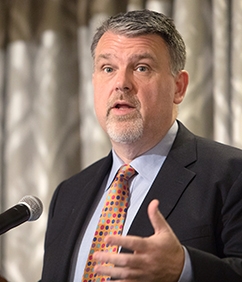Terrorist threats won't go away, but they have changed, says former National Counterterrorism Center head
Two months after stepping down as director of the National Counterterrorism Center (NCTC), Nick Rasmussen joined Lisa Monaco, Distinguished Senior Fellow at the Center on Law and Security (CLS), on February 15 for a discussion of evolving threats to the United States and strategies to counter those risks. The conversation was the first of a series of CLS events on the theme of resilience in the face of national security challenges.
In his conversation with Monaco, Rasmussen discussed shifting tactics used by terrorists targeting the US from abroad, as well as internal risks such as homegrown extremism and the widespread availability of firearms. Rasmussen noted that the government’s national security priorities must adapt to changing conditions. “I’m a terrorism guy, a counterterrorism guy,” he said, “but I would not tell you that that’s a more important problem than what we are facing with North Korea right now.… The work we are doing to confront the North Koreans, prevent the growth of the Iranian nuclear program—those to me are every bit as pressing a national security problem as terrorism is.”
Select remarks by Nick Rasmussen:
“The ability of the US government to deliver a solution in Afghanistan, in Syria, the Horn of Africa, Yemen, the southern part of the Arabian Peninsula, and therefore dry up the terrorism problem or eliminate it… I’ve gained more humility over time about our prospects of actually accomplishing that. And that doesn’t make me a fatalist, it just means the terrorism problem we face is likely to persist at roughly the level we are facing it into the foreseeable future. And I don’t think that has to be viewed as a catastrophe, because while that threat level has persisted, we have also dramatically increased over time our ability to defend ourselves.”
“It [is] just simply the case that it is true in this country we make guns more available, and so an individual who has terrorist intent, if he or she decides to use firearms, that’s an option that’s readily available to them, legally or illegally. So that’s something for us to grapple with.”
“One of the things that’s made the homegrown extremism problem challenging for us is that usually when we look back at almost every one of these cases, there isn’t a single pathway by which person A moved from being a consumer of extremist material online to an active shooter or terrorist…. In most cases, it ends up being a combination of factors that… can include mental illness, it can include other potential stressors in their life, it can include absolutely pure ideological devotion, or it can include all of the above. I can remember a number of cases in which—this is going to sound more flippant than I mean it—we’d talk among our analysts and say, ‘Well, was this person a terrorist, or were they crazy?’ The answer was ‘Yes.’”
Watch the full video (1 hour, 8 minutes):
Posted March 8, 2018



